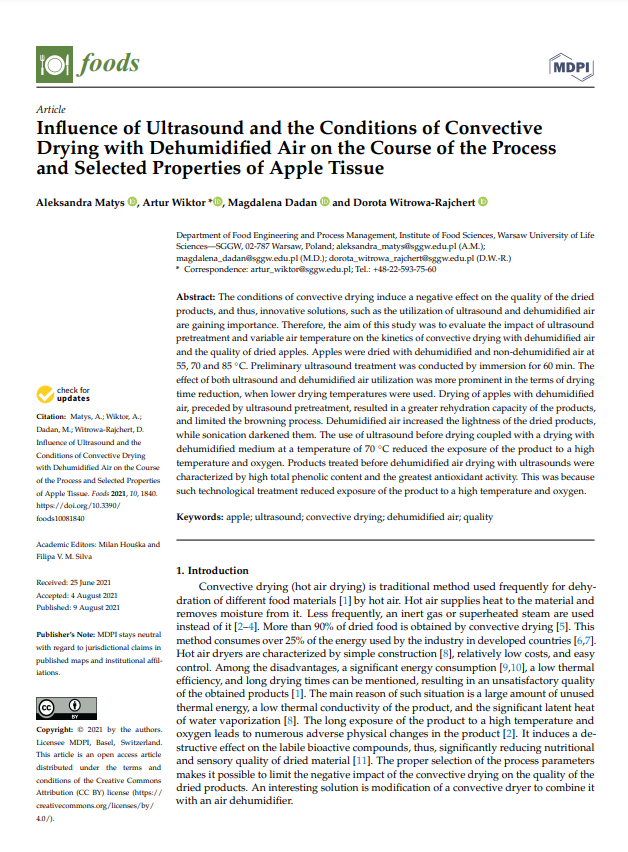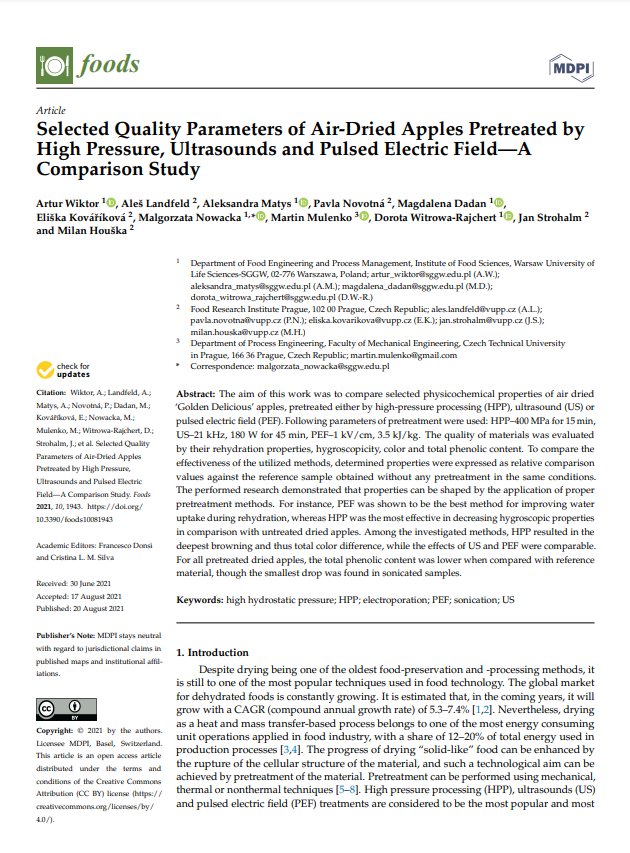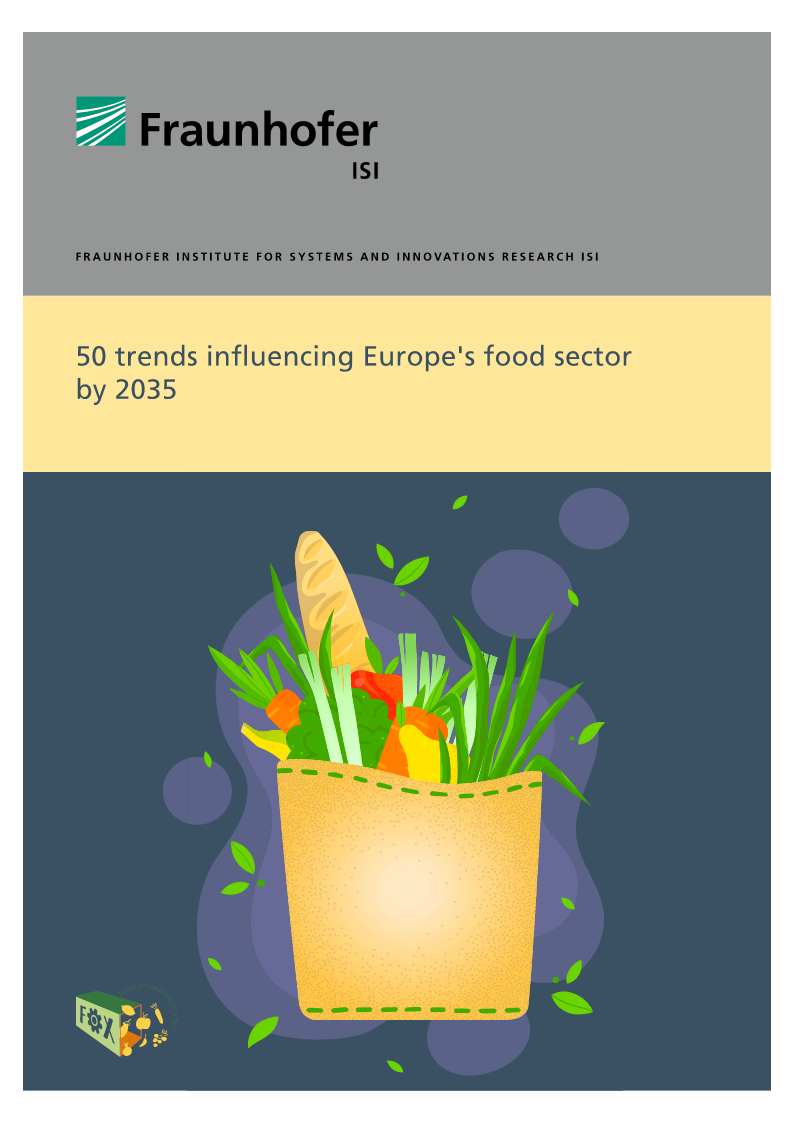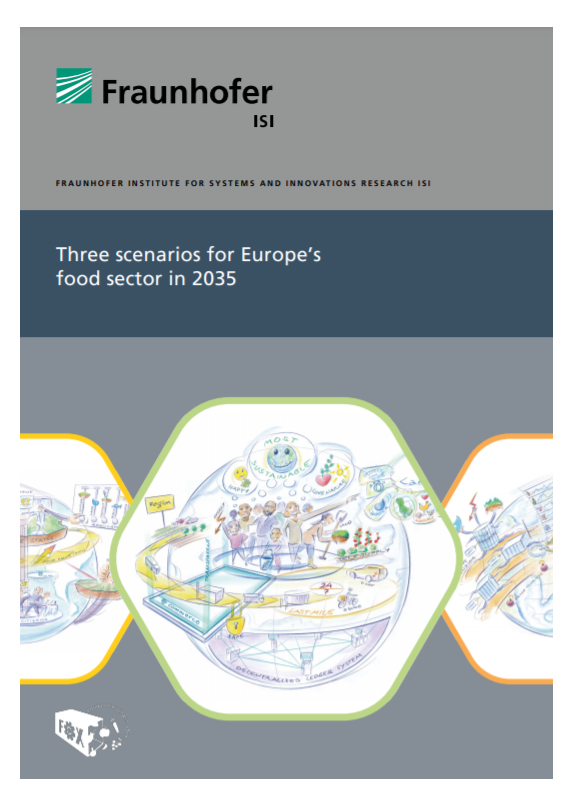Article: Influence of Ultrasound and the Conditions of Convective Drying with Dehumidified Air on the Course of the Process and Selected Properties of Apple Tissue
The conditions of convective drying induce a negative effect on the quality of the dried products, and thus, innovative solutions, such as the utilization of ultrasound and dehumidified air are gaining importance. Therefore, the aim of this study was to evaluate the impact of ultrasound pretreatment and variable air temperature on the kinetics of convective drying with dehumidified air and the quality of dried apples. Apples were dried with dehumidified and non-dehumidified air at 55, 70 and 85 °C. Preliminary ultrasound treatment was conducted by immersion for 60 min. The effect of both ultrasound and dehumidified air utilization was more prominent in the terms of drying time reduction, when lower drying temperatures were used. Drying of apples with dehumidified air, preceded by ultrasound pretreatment, resulted in a greater rehydration capacity of the products, and limited the browning process. Dehumidified air increased the lightness of the dried products, while sonication darkened them. The use of ultrasound before drying coupled with a drying with dehumidified medium at a temperature of 70 °C reduced the exposure of the product to a high temperature and oxygen. Products treated before dehumidified air drying with ultrasounds were characterized by high total phenolic content and the greatest antioxidant activity. This was because such technological treatment reduced exposure of the product to a high temperature and oxygen
Article: Selected Quality Parameters of Air-Dried Apples Pretreated by High Pressure, Ultrasounds and Pulsed Electric Field—A Comparison Study
The aim of this work was to compare selected physicochemical properties of air dried ‘Golden Delicious’ apples, pretreated either by high-pressure processing (HPP), ultrasound (US) or pulsed electric field (PEF). Following parameters of pretreatment were used: HPP–400 MPa for 15 min, US–21 kHz, 180 W for 45 min, PEF–1 kV/cm, 3.5 kJ/kg. The quality of materials was evaluated by their rehydration properties, hygroscopicity, color and total phenolic content. To compare the effectiveness of the utilized methods, determined properties were expressed as relative comparison values against the reference sample obtained without any pretreatment in the same conditions. The performed research demonstrated that properties can be shaped by the application of proper pretreatment methods. For instance, PEF was shown to be the best method for improving water uptake during rehydration, whereas HPP was the most effective in decreasing hygroscopic properties in comparison with untreated dried apples. Among the investigated methods, HPP resulted in the deepest browning and thus total color difference, while the effects of US and PEF were comparable. For all pretreated dried apples, the total phenolic content was lower when compared with reference material, though the smallest drop was found in sonicated samples
Brochure: 50 trends influencing Europe’s food sector by 2035
Europe 2035 – What are we going to eat? Where will we do our grocery shopping? How can we produce food using fewer resources? Who can benefit most from new trends? Which other industries will affect the food industry? What will the food sector look like? These questions are part of the EU Horizon 2020 project FOX, and are at the core of FOX’s foresight research component.
The Competence Center Foresight of the Fraunhofer Institute for Systems and Innovation Research ISI derives and conducts foresight processes for developing future scenarios that outline the framework conditions of the European food innovation system of 2035.
As part of this process, scientists and experts have identified and analyzed a variety of trends influencing the food sector. The most compelling 50 are presented as “trends to go” in this brochure. With additional information, the 15 most relevant trends are explained in more detail as “trends à la carte”.
Brochure: Three scenarios for Europe’s food sector in 2035
Vertical farming and urban gardening, artificial intelligence in food retail, burgers made from insects as alternative proteins, or online grocery shopping – many social trends and technologies are influencing the food system today and will shape how the European food sector will look like in 2035. These trends are already apparent today, but which of them could change the whole food system on the long term? Which trends are only hypes and temporary? These and many other questions are part of the EU Horizon 2020 project FOX, and are at the core of FOX’s foresight research component.
Taking the “50 trends influencing Europe’s food sector by 2035” as a starting point, an online foresight scenario process was designed and conducted to draw three alternative pictures of the future, how the European food sector could look like in 15 years. The aim is not to predict exactly how the food sector will develop because this is impossible. However, the aim is to contribute to the discussion by reflecting and studying possible influencing aspects and alternative futures, as a look into the future creates the possibility to develop together ideas for improvement strategies to be better prepared.




